In July 1996, Disneyland Paris celebrated Space Mountain’s one year anniversary with an impressive and unexpected announcement: Euro Disney S.C.A. had made its first ever quarterly profit: $35 million. During the 1995 fiscal year, attendance at the resort had surged from 8.8 million to 10.7 million – a staggering 21% increase – and hotel occupancy reached an all-time high of more than 68%.
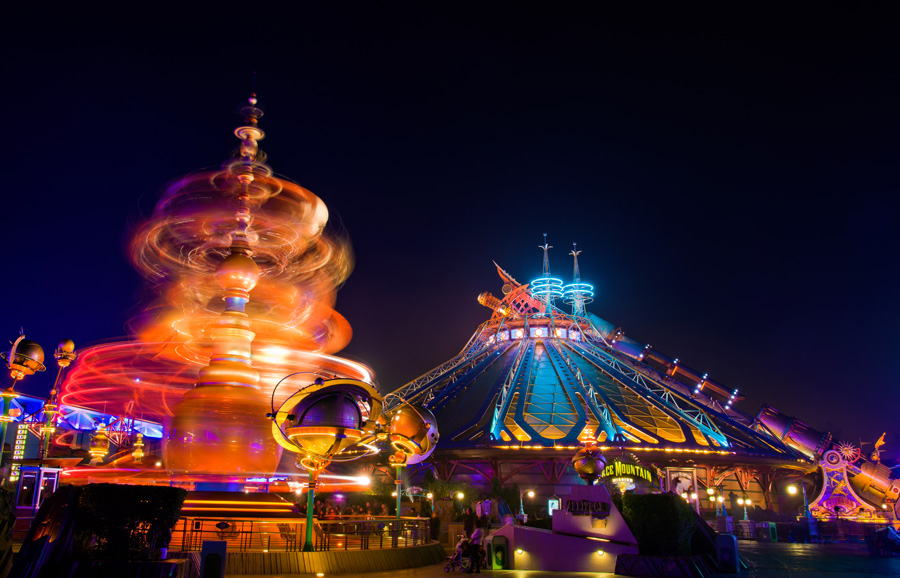
Here’s the point: Space Mountain saved Disneyland Paris. Analysts and industry experts agree that without the $100 million investment in Discoveryland, the European park would’ve been sunk.
Unfortunately, the Resort still hasn’t gained absolute stability even twenty years later… Because even as the resort seemed to grow into itself and gain traction, contractual obligations and Michael Eisner’s ill-fated Disney Decade (the same terrible forced growth spurt that gave us the underbuilt Disney’s California Adventure and Hong Kong Disneyland) mandated that Disneyland Paris – finally treading water – be joined by what is objectively the most embarrassing Disney Park on Earth. (We walked through the abysmal second gate Paris received in its own must-read feature, Declassified Disasters: Walt Disney Studios Park.)
Without a doubt, Walt Disney Studios has been an albatross around Disneyland Paris’ neck, necessitating that any and all capital investment projects be pulsed into the Studios. In fact, the last major, from-scratch E-Ticket Disneyland Parisopened was… yep… 1995’s Space Mountain. As Walt Disney Studios dragged the resort down, Disney turned once again to their golden egg to reinvigorate the resort.
Space Mountain: Mission 2 (2005 – 2016)
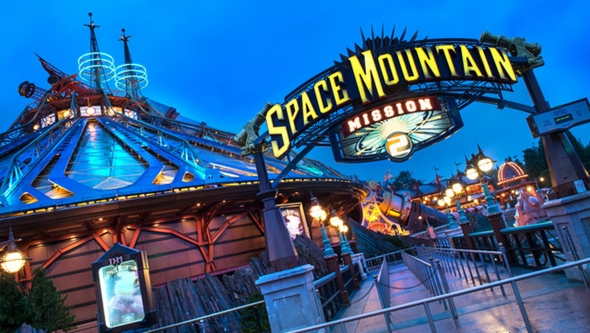
Space Mountain was closed in January 2005 so that it could re-open for the mountain’s 10th anniversary in April. But now, the golden peak would be home to Space Mountain: Mission 2. The ride was stripped of its Jules Verne narrative in favor of the sci-fi styling of the American mountains.
Now “a journey beyond the moon, to the very edge of our universe,” the ride was rescored by Michael Giacchino (composer for Lost, Alias, The Incredibles, and the on-board audio for Disneyland California’s Space Mountain) with a sci-fi futuristic score.
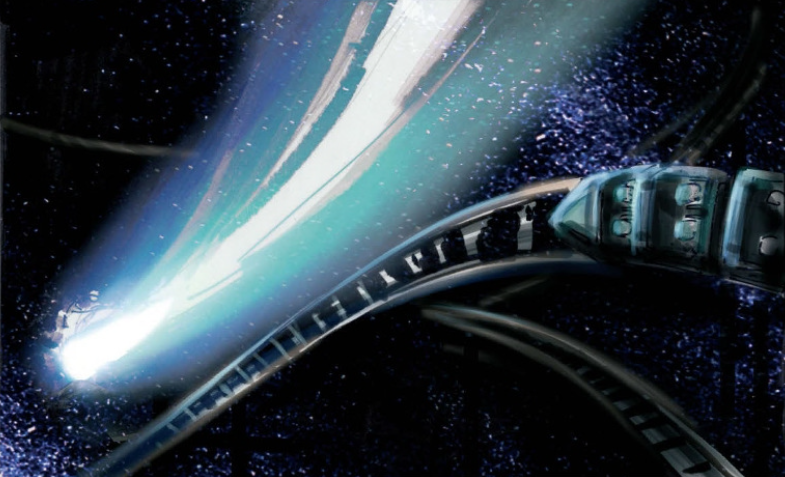
Don’t misunderstand – many fans would happily call Space Mountain: Mission 2 the best of the world’s Space Mountain rides, with astounding effects, a perfect score, and a thrill no other Disney coaster could match. The modern-built coaster remained a breathtaking experience, incorporating many of the sights from “De la Terre à la Lune,” new sounds based on the sci-fi score in California, and some new special effects (including an iconic reentry tunnel of curved neon tubes).
You can watch a point-of-view video of the updated Space Mountain: Mission 2 here:
The problem is that, while the elegant exterior still made Paris’ Space Mountain a sight to behold, it was now a gilded shell… the ornate Victorian steampunk style concealed a roller coaster through the stars no more romantic or literary than Magic Kingdom’s; a sci-fi ride behind a fantasy façade.
The cannon might as well have been replaced with a modern NASA “launch pad” and the mountain covered in white geometric panels. Mission 2 took what made Paris’ mountain (and all of Discoveryland) unique and stamped it out, bringing it in line with the standard Space Mountain ride found in Orlando, Anaheim, and Hong Kong.
But for fans of De la Terre á la Lune, the worst was yet to come.
Sci-Fi Land
The brave decision to forego common Tomorrowland tropes in Paris’ Discoveryland is precisely what made it so unique. To recast the land as a copper port with Le Visionarium (transported to Magic Kingdom’s ensuing New Tomorrowland as The Timekeeper), Mysteries of the Nautilus, the grounded golden Orbitron, and Space Mountain: De La Terra a La Lune was groundbreaking and astounding.
And almost right away, it began to disintegrate.
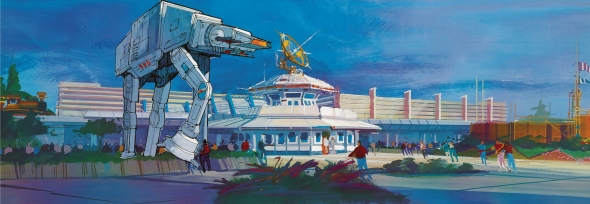
Sure, there was no way the park’s future-themed land could’ve escaped without a Star Tours, as mismatched as it might’ve been from the overarching story. And from the park’s opening, it was there in a fittingly mismatched ‘80s sci-fi building at the rear of the land. But in 2004, the Lost Legend: The Timekeeper in the land’s Le Visionarium closed to make way for Buzz Lightyear Laser Blast – based on Disney-Pixar’s Toy Story 2. Then, the uniquely European Space Mountain became the generic Space Mountain: Mission 2 the very next year.
Already, the brave Discoveryland was becoming nothing more than a gilded Tomorrowland. Beneath its ornate, Victorian, European exterior, Discoveryland would now serve as a catch-all for anything Pixar or Star Wars, just like its Tomorrowland cousins.
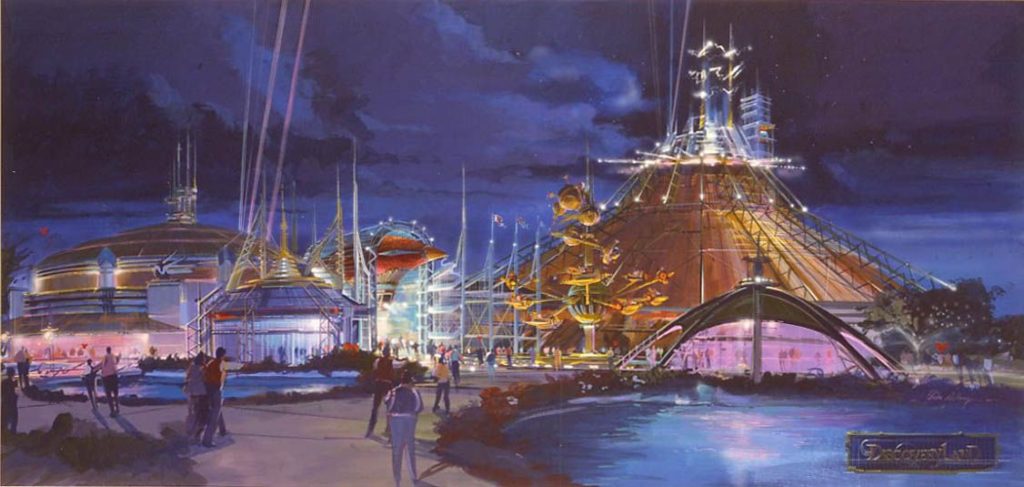
In 2014, though, rumors began to swirl that Paris’ next update to Space Mountain for the resort’s 25th Anniversary might restore the Jules Verne storyline to its former grandeur, once again making the park’s signature ride match its glorious exterior. Fans were certain that the reborn ride would bring with it the original orchestral on-board audio, the Georges Méliès accents, and brand new trains without the over-the-shoulder restraints that had become so uncomfortable over the years. And how wonderful would it be to see the heart of Discoveryland returned to its prime? And maybe it really was the plan!
But a change in California quickly derailed any hopes of a reborn Discoveryland.
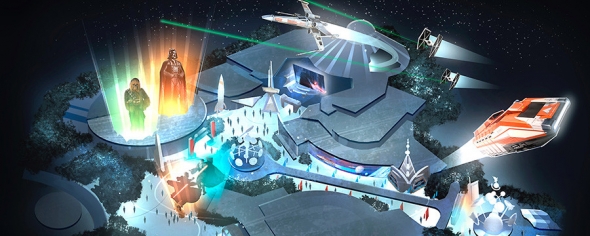
In 2015, Disneyland in California debuted a seasonal event they called “Season of the Force,” celebrating Star Wars by effectively overtaking the park’s Tomorrowland entirely. Joining the already-existing Star Tours, the highlight of the event, by far, was the temporary transformation of Space Mountain into Hyperspace Mountain. Within the peak, the projection screens used annually for Halloween’s Space Mountain: Ghost Galaxy instead became home to Star Wars projections as your trip through space became a wild race on a resistance mission.
As odd as it was to have Star Wars laying claim to Disneyland’s iconic Space Mountain, it didn’t feel at all anachronistic. After all, Space Mountain opened literally two days – forty-eight hours! – after Star Wars debuted in theaters. Products of the same era, time, and generation, their looks and feels are somewhat complementary, making 1977’s Star Wars a comfortable temporary resident of 1977’s Space Mountain. And Disneyland’s Hyperspace Mountain was an incredible overlay and a truly awesome ride in its own right, as you can see in this amazing on-ride video:
Quickly, the Hyperspace Mountain overlay was transplanted to Hong Kong Disneyland (its Space Mountain being an exact replica of Disneyland’s), and it was only a matter of time until the announcement fans feared was made…
Hyperspace Mountain: Rebel Mission (2017)

On January 8, 2017, Paris’ Space Mountain: Mission 2 closed.
When Space Mountain re-opens to celebrate the park’s 25th Anniversary, it’ll have its third name: Star Wars Hyperspace Mountain: Rebel Mission. Evidence suggests that this is not a temporary, seasonal overlay… it’s a permanent new identity for the mountain, coinciding with new trains (with more comfortable restraints… And as observant fans have noticed, those new new trains are decked out in Victorian cogs, golden sunbursts, and red velvet-stylized seats… which suggests that Imagineers at least hope for the mountain to get back some semblance of Discoveryland some day.)
In any case, Hyperspace Mountain is, of course, a massively fun and extraordinary attraction in its own right. While it doesn’t bother to explain why guests would be launched from a golden cannon to enter the Star Wars universe, such anachronisms have become par for the course in Disney’s recent (often hasty and thoughtless) attempts to pulse blockbuster movies into their parks regardless of design, narrative, or long-term fit.
Check out a video of Paris’ newest incarnation of Space Mountain here. If you’ve been paying attention, you’ll likely recognize some moments and even props that are analagous to the original De la Terre à la Lune ride through:
Paris’ Hyperspace Mountain joins Guardians of the Galaxy – Mission: BREAKOUT! and Pixar Pier in California Adventure as a growing subset of Imagineering projects that would probably be intriguing, unique, and welcome offerings if Disney only made them “for a limited time.”
But by permanently converting fan-favorite rides to fit current box office hits and high-earning intellectual properties, they cast a heavy shadow of doubt on the long-term strategy for Disney Parks. This “Universal” M.O. is seemingly content with measuring ride lifetimes in seasons rather than decades; a major shift for Disney Imagineering.
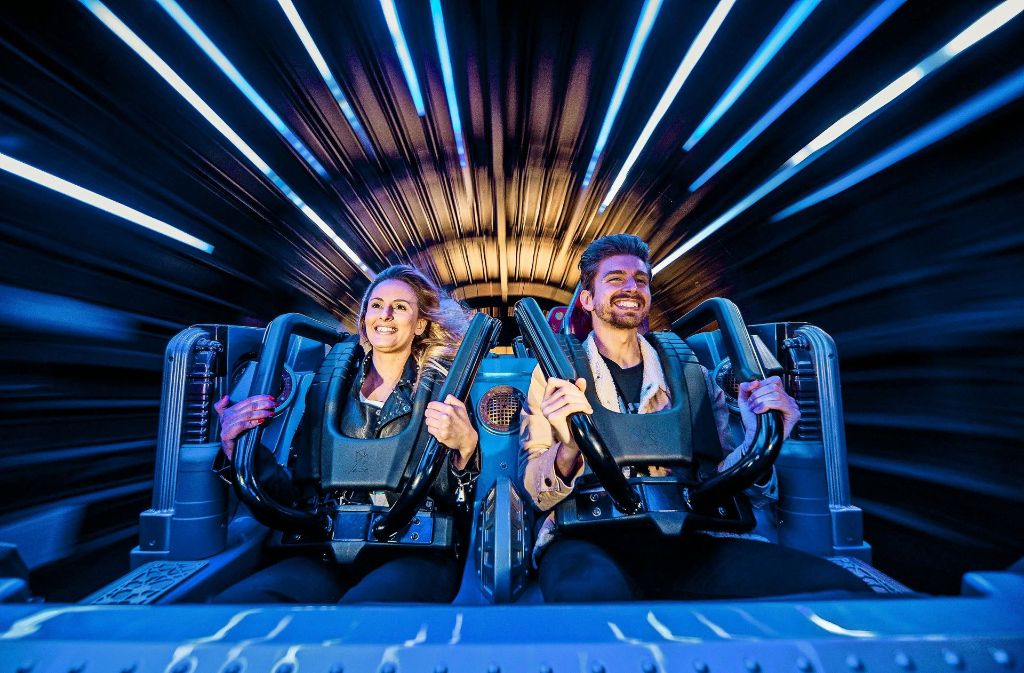
We’d like to think that if Tony Baxter hadn’t retired from Imagineering in 2013, these shortsighted and story-killing decisions wouldn’t be being made. But we also suspect he might’ve retired specifically because he saw these maligned concepts coming down the pipeline and knew he was powerless to stop them.
The Future is in the Past
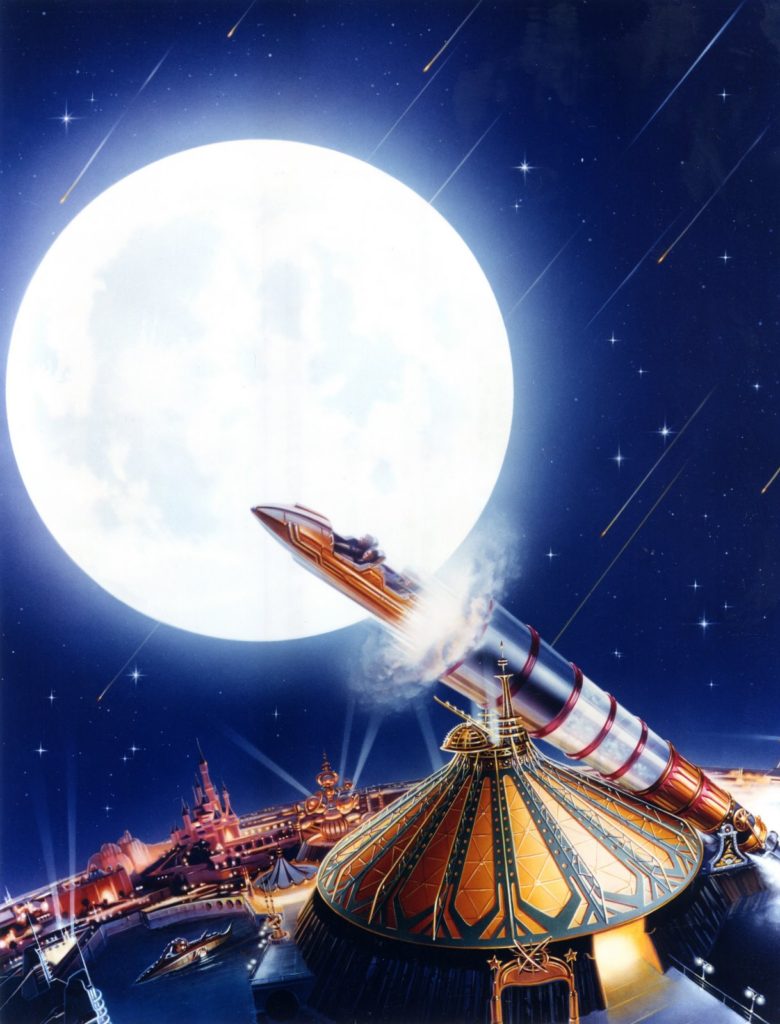
Despite fans’ desires, one thing seems abundantly clear: it’s unlikely that any semblance of Jules Verne’s fantasy worlds will return to Disneyland Paris in the near future. Not while the current regime is in charge, at least. And that is too bad.
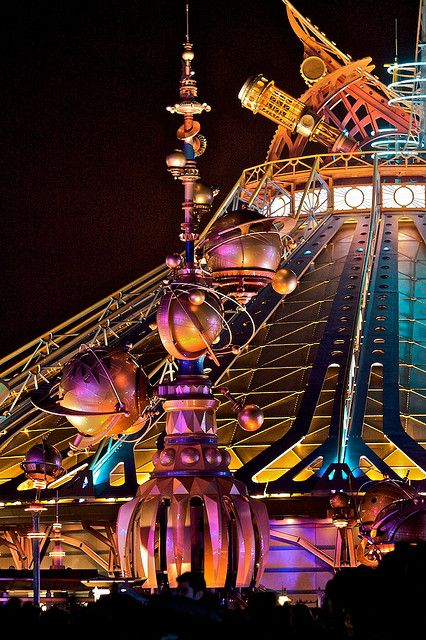
We’ve made the case before that Disney only hurts itself when it shelves original concepts in favor of box office tie-ins. By following Universal’s lead and aggressively inserting whatever’s hot into their parks at the expense of timeless entries, Disney and its executives are forgetting to play the long game.
What we hope for is that one day, another Imagineer like Tony Baxter rises through the ranks and is able to convince a new generation of Disney’s executives that there’s merit in originality and risk; that brave new concepts are worth exploring; that a ride is worth building even without a box office hit behind it; and that classics should be restored and revered. It would sure save us a lot of writing of future Lost Legends entries…
And just like that, the story of Disneyland Paris’ one-of-a-kind Space Mountain comes to a close. A masterwork of Imagineering, this mountain was decades in the making. It was a “best-of” masterpiece fusing French cinema, Jules Verne’s stories, Disney’s most intense coaster ever, and the long-lost lore of Discovery Bay to create a uniquely-European take on what a journey to the moon could be.

Thank you so much for reading. Now, it’s your turn to join the story. If you enjoy spending time falling down the “rabbit hole” of Park Lore’s in-depth, ad-free, member-supported stories, consider becoming a Member for as little as $2 / month.
Members can unlock rare concept art in every tale, reveal attraction audio streams in select stories, gain access to over a hundred exclusive articles in our quick-read Extra Features and in-depth Special Features collections, gain exclusive podcast extras, and receive an annual member card and merch in the mail! (Plus, y’know, supporting research-based, ad-free, clickbait-free, in-depth theme park writing!)
Then we want to hear from you. What do you think? Did you know that Disneyland Paris and its Space Mountain were so unique among Magic Kingdom style parks? Have you ever had the chance to experience their one-of-a-kind ride through the stars? Should Disney respect and reinforce rides that fans crave, or does it make more sense to appeal to the masses by inserting hot intellectual properties, even overtop of classics?


